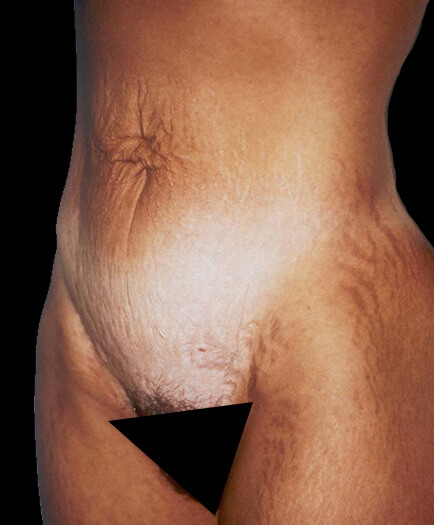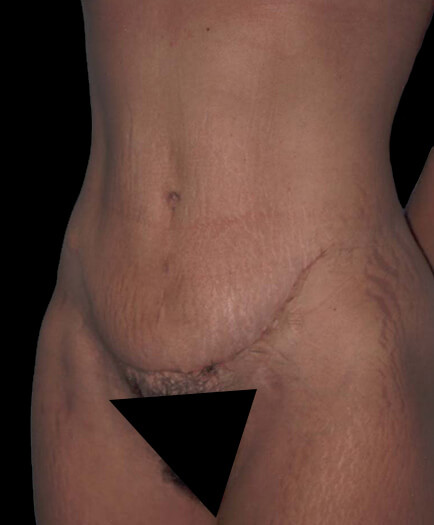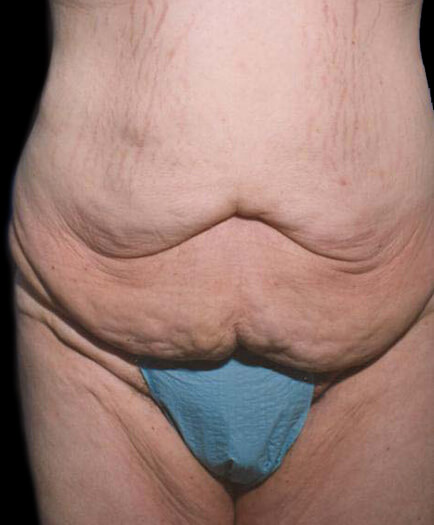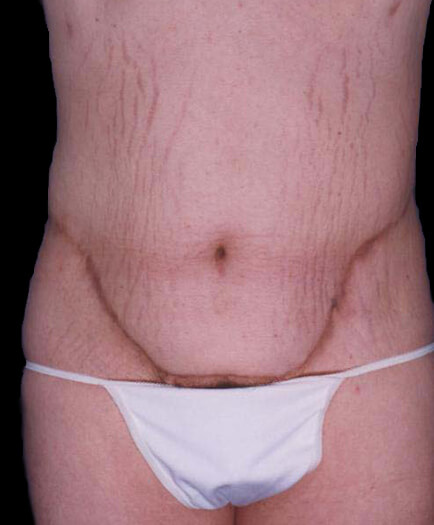Sometimes, after multiple pregnancies or large fluctuations in weight, the tissues of the abdominal wall lose their elasticity and become lax and flaccid. The person may have localized accumulations of fat in the abdomen that have persisted despite exercise. Stretch marks from pregnancies may cover the skin of the lower abdomen and occasionally go as far as the mid-abdominal area. The purpose of abdominoplasty (tummy tuck) is to eliminate many of these deformities and to give the abdomen a tighter, firmer, and more pleasing contour.
Abdominoplasty is not just an operation for women. Men who have had large amounts of weight loss or who have localized fat in the stomach area may also benefit from this tummy tuck surgery. It must be remembered that a tummy tuck is not a substitute for more conventional methods of weight loss, such as dieting and exercise. However, in certain individuals, accumulations of fat in these areas do not respond to normal measures, and for these individuals, a Virginia tummy tuck can provide a means to achieve this goal.
A tummy tuck is best thought of as a spectrum of surgical procedures that can be tailored to your specific need. In other words, not every person requires an extensive procedure, and, depending on the situation, the patient may be able to get by with doing less. Often, a Virginia tummy tuck procedure is done in conjunction with liposuction (fat removal), which enables the surgeon to enhance the end result of surgery and to put finishing touches where necessary.
The tummy tuck operation is done using general anesthesia or regional anesthesia and sedation. Depending on the extent of skin laxity or excess, the incision may be long or short but is almost always hidden in the bikini area. Today, we have the ability to perform a Virginia tummy tuck with short scars if the patient has a relatively small degree of skin laxity. This is called the partial tummy tuck or short-scar abdominoplasty. If the skin that needs to be removed distorts the naval, it may be necessary to reposition this structure so that its ultimate location is as it was before. Muscle and facial layers under the skin can be tightened to make the abdomen firmer and flatter. Such maneuvers under the skin help contour the shape of the abdomen and can sometimes result in a narrower waist and give an hourglass appearance to the female patient.
Unless there is a clear indication for postoperative observation in a hospital, you may go home after tummy tuck surgery. You will have a moderate degree of discomfort in the first few days after tummy tuck surgery that is easily controlled with oral pain medication. Swelling and discoloration from the tummy tuck surgery will depend on the extent of the procedure, but, generally, most of it will be gone in 1-2 weeks. You will be able to return to most usual activities by the end of the first week and resume strenuous exercise in a few weeks. A support garment is recommended for approximately 2 months to ensure proper healing. Minor changes in sensation are not unusual for a short period after tummy tuck surgery.
Abdominoplasty is a procedure that is designed to improve the shape of the abdomen and mid-body of both men and women. It is commonly called tummy tuck.
With abdominoplasty, you can dramatically improve your mid-body shape. A Virginia tummy tuck can permanently remove fat, tighten loose muscles, and trim excess skin. There are different kinds of abdominoplasty, ranging from a complete tummy tuck to minimal incision operations that address specific problems in the abdomen.
In the first consultation, you will have a chance to discuss your concerns with our patient care coordinators and Dr. Marefat. We will explain what you need to know about the tummy tuck procedure and help to determine what is best for you. You will receive information booklets and pricing on the tummy tuck procedure.
A tummy tuck is done by first liposuctioning the abdomen if necessary. This suctioning is limited to a safe amount to not jeopardize the viability of the abdominal skin. The tumescent solution used in liposuction is also used for abdominoplasty. This significantly reduces blood loss and the need for hospitalization. The muscles above and below the belly button are then folded. This makes a big difference in the protrusion of the abdomen that is seen in women after pregnancy. It also gives the abdomen a more defined hourglass shape. Finally, the excess skin is trimmed from the lower part of the abdomen.
Before you focus on the complications of a Virginia tummy tuck procedure, first consider how best to digest these bits and pieces of information. Reading about complications can be quite scary. Many people cannot comfortably sit through a consultation session without having some real doubts about surgery. But it is different when you have these complications explained to you by a doctor. Dr. Marefat can put them in perspective for you and tell you the likelihood of such complications occurring. Most complications are very rare. Some are less rare and need to be explained to you in more detail so that you know how we would tackle these problems if they occurred. The purpose of explaining risks and complications is for you to know what steps we would take to treat you and put you back on the road to recovery. Remember that every surgeon has his or her own way of treating problems. You must go over these potential risks with your surgeon to gain better insight and understanding.
After tummy tuck surgery, you will have a moderate amount of drainage from the incisions. You may have drains under the skin to collect some of this extra fluid. You will need to rest for 2-3 days, but most people are up and about shortly after surgery. We generally recommend our patients take off 7-10 days from work. Heavy lifting and exercising should be avoided in the first 2-3 weeks. Your body will tell you when you are ready to get back into your regular exercise routine. Most people are able to return to their normal exercise level in 4-6 weeks.
The sutures in abdominoplasty come out in 10 days. Sometimes, you may have absorbable sutures that do not need to come out.
We like to see our patients frequently after surgery. You are seen by the doctor or nurse within 2-3 days of tummy tuck surgery. Then, the normal postoperative routine is 1 week, 1 month, 3 months, 6 months, and 12 months after surgery. Of course, if there is a need, you may be seen more often. After a year, we encourage our patients to come in for routine follow-up visits every 3-5 years.
You should be able to wear makeup if you have had abdominoplasty. However, we do not recommend putting makeup on your incisions. This may result in tattooing of the skin by the pigments in the makeup.
You are a good candidate for abdominoplasty if you have good general health and realistic expectations. The best results are seen in individuals who do not have large amounts of fat that needs to be removed. In such cases, it is better to stage the operation so that some of the fat is removed before the actual tummy tuck. Generally, the younger you are, the better a candidate you are for surgery. A person’s physiological age is more important than his or her chronological age. That is to say, you may be 60 years old, but your skin and general health may be better than that of a 50 year old.
You can pay for tummy tuck surgery by certified check, credit card, or cash. Payment for cosmetic surgery is expected prior to any procedure. If you are scheduled for surgery several weeks in advance, you may pay by personal check.
Yes. The length of the scar will vary according to the procedure you need. If a mini-abdominoplasty is being done, the scars are very short. If a full abdominoplasty is being done, the scars are longer. You usually will also have a scar around the belly button, and you may have a small scar between the belly button and the pubic hairline. After several months, these scars fade and become less visible. Remember that a tummy tuck is an operation that strives for shape in exchange for scars. You must be comfortable with this idea.
The pain involved in abdominoplasty is very tolerable. We have heard our patients describe it as muscle aches and pains or soreness. Many patients say that it was better than what they expected. Having said that, remember that pain is very subjective, and it is not easy to predict what degree of pain you will have. Since muscle is not cut in a tummy tuck, the pain level is usually not as bad as most other operations like C-sections or hysterectomies.
Not usually. If you are having a large area of liposuction and undergoing abdominoplasty at the same time, you will have the operation in an outpatient facility under general anesthesia. Minor lower abdominal skin excisions can sometimes be done under local anesthesia.
Virginia tummy tuck surgery is usually done in an outpatient facility. Only in rare situations where the patient may have risk factors does Dr. Marefat suggest surgery in a hospital environment. Minimal skin excisions could be done in the office, but this is very seldom done.
BEFORE

AFTER

BEFORE

AFTER

Yes. In all cosmetic and reconstructive cases, medical photos are taken. Photographs are mandatory because this is the only way for us to compare your before and after results. Photographs in plastic surgery serve the same role as x-rays do in orthopedic surgery.
Dr. Marefat and the staff at Metropolitan Plastic Surgery would be happy to help you set up a private consultation to discuss tummy tuck (abdominoplasty) in Virginia. Schedule an appointment online or call one of our locations at 703-516-7600 (Arlington area) or at 703-560-9583 (Woodbridge).
Dr. Marefat offers a number of financial assistance programs and payment programs to cover the cost of a tummy tuck (abdominoplasty) in Virginia. Please visit the patient financing section of our website for more details or ask the staff at Metropolitan Plastic Surgery about these options so that you can get started with a tummy tuck (abdominoplasty) in Virginia today.